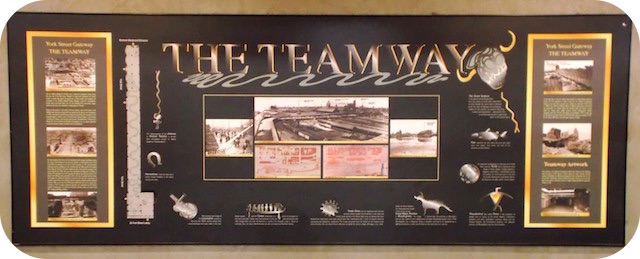Discover Toronto's history as told through its plaques
2004 - Now in our 14th Year - 2018
To see what's new on this site, you can visit the Home Page
Looking at this page on a smartphone?
For best viewing, hold your phone in Landscape mode (Horizontal)
The Teamway

Photos and transcription by contributor Wayne Adam - Posted October, 2015



On the west side of York Street, a few steps south of Station Street, in a pedestrian tunnel, facing south, can be seen this plaque. Here's what it tells us:
Coordinates: 43.644514 -79.382232 |
 |
You are walking through the Teamway, now a pedestrian passageway running along the west side of the York Street "subway" or tunnel and underneath the railway viaduct. In earlier days, goods arriving by train at Union Station were unloaded and transferred to the Canadian National Express Building, a depot for transshipment, located above and beside where you are now standing. Here, horse-drawn wagons picked up the items from teamways or loading bays for delivery.
Owing to the decline in rail traffic in the last decade, many of the tracks in the Railway Lands have been removed. This has opened up the area for new development. In 1995, nearly half of the York Street subway was demolished. The renovation of the Teamway began in 1997 as part of the York Street Gateway Project, a joint venture involving the federal and provincial governments (Canada/Ontario Infrastructure Works), the City of Toronto and Marathon Developments Inc., to improve pedestrian connections between Toronto's downtown and its harbourfront.
The area between Front Street and the harbourfront has changed significantly during the course of local history. At one time, the shoreline of Lake Ontario was at Front Street. With the founding of the Town of York (Toronto) in 1793, came European settlement and the development of the waterfront. By the 1840s, much of the original beach along the shoreline had been replaced by piers constructed for passengers and cargo ships. By the 1850s, there was also considerable development of railways in Toronto. The Esplanade Act of 1853 granted the right-of-way along the shore to the Grand Trunk Railway, which proceeded to fill in this area to provide land for tracks. Thus began the southward expansion of land into the lake. The construction of privately owned wharfs also continued, and the shoreline gradually moved southward until, by 1900, it was more then 300 metres (984 feet) south of its original line. Starting in 1913, a further southward expansion was undertaken by the Toronto Harbour Commissioners. The location of Toronto's shoreline today is a result of the THC's ongoing lakefilling activities.
In the early days, as now, the railway tracks divided the central business district of Toronto from the waterfront. In order to help solve the problem of pedestrians having to cross the tracks at grade level, a bridge was constructed at York Street in 1896/97. By 1909, the Dominion Board of Railway Commissioners had ordered the construction of a railway viaduct, thus allowing people and vehicles to move under the railway tracks through subways. However, disagreements delayed completion until 1931. The York Street Bridge was dismantled in 1927 to make way for the present day Union Station, and the York Street subway was opened in 1931. At 213 metres (700 feet), it was the longest subway in Toronto.
Teamway Artwork
The artwork in this pedestrian passageway reflects the evolution of the Teamway from the shores of Lake Ontario to Union Station. Ten major elements, focusing mainly on Anishnawbe (or Ojibway) cosmology, have been incorporated into the "art on the floor". Anishnawbe people inhabited the Greater Toronto area at the time John Graves Simcoe, Lieutenant Governor of Upper Canada, founded the settlement of York in 1793.
Related webpages
Town of York
pier
Grand Trunk Railway
Toronto Harbour Commission
viaduct
Anishnawbe
Upper Canada
Related Toronto plaques
Union Station
Lieutenant-General John Graves Simcoe 1752-1806
More
Transportation
Here are the visitors' comments for this page.
(none yet)
Here's where you can send me a comment for this page.
Note: Your email address will be posted at the end of your comment so others can respond to you unless you request otherwise.
Note: Comments are moderated. Yours will appear on this page within 24 hours (usually much sooner).
Note: As soon as I have posted your comment, a reply to your email will be sent informing you.
To send me your comment, click [email protected].
Thanks
Webmaster
Note: If you wish to send me a personal email, click here.